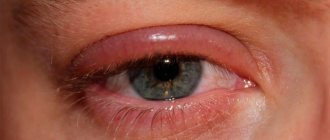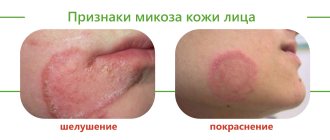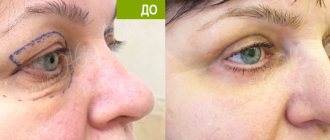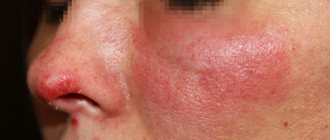A furuncle is an inflammatory process that affects the hair follicles and surrounding tissues, characterized by a purulent-necrotic reaction and intoxication of the entire body. The main pathogens are ingested pyogenic bacteria, mainly Staphylococcus aureus. The main reasons for the occurrence of such a pathology can be: microscopic injuries to the skin (from shaving, depilation, ingrown hairs, dry skin, scratching, etc.), disruption of the metabolic response and immune defense of the surface layers, skin contamination and blockage of the ducts of the glands located next to the follicle , impaired sweating and sebum secretion, hypo- and avitaminosis, endocrine disorders.
A boil, as a skin disease, is characterized by a staged process:
- Development of infiltrate within 1-2 days (hyperemia of the skin, thickening, the skin stretches and becomes flattened, shiny over the area of formation of the pathological process, extremely painful);
- On the 3-4th day, suppuration of the follicular pustule occurs, with a necrotic center;
- Rejection of the necrotic core of the boil;
- The healing process with scarring lasts up to 10 days.
In addition to a local reaction, a boil is characterized by intoxication of the body. Often there is a temperature reaction to the infectious agent and pus, as well as general weakness.
A boil can be treated either conservatively or surgically. In the first stages, local anti-inflammatory drugs and antiseptics may be prescribed. The skin at the site of hyperemia is thoroughly cleaned (disinfected with iodine or alcohol solution), applications with ichthyol ointment are applied, dry heat and UHF are applied. After opening the boil during the process of discharge of purulent-necrotic masses, a wet-dry bandage and applications with a hypertonic solution are applied, this promotes better discharge of pus. After complete cleansing of the ulcer, antibacterial ointments are applied to the wound; levomekol is excellent. When the process is localized to the face, severe complications (purulent meningitis or sepsis) may occur, so systemic antibacterial drugs must be prescribed. In general terms, the medical impact for this pathology is the same for any location, although there are minor differences in the clinic and treatment methods. The surgical method is used when it is impossible to remove the purulent-necrotic rod on its own.
Furuncle in the ear
A boil in the ear receives therapeutic treatment with minor differences. The opening and rejection of necrotic masses may be accompanied by their flow into the middle ear, which is very unfavorable and dangerous for the hearing organ, therefore the use of dry heat, which can also contribute to the occurrence of sepsis, is not recommended. It is recommended that the patient sleep on the affected side to prevent swelling. Be sure to contact an otolaryngologist. The specialist manages the patient conservatively throughout the entire period and only if necessary can perform minor surgery. Under no circumstances should you attempt to clean your ears at this time, squeeze out the boil, or carry out any other activities. The vascular network on the head is very well developed, so in this location it is necessary to approach treatment methods very carefully so as not to cause life-threatening complications. In addition to the local reaction, severe headache, loss of appetite, fever, and irritability often occur. When such a clinic develops, symptomatic additional treatment is prescribed: antipyretic, anti-inflammatory, analgesics.
Prognosis and prevention
Single boils that occur without complications completely disappear within 2-3 weeks.
With relatively frequent relapses (exacerbations once a year or more often), the likelihood of complications is much higher. In this case, regular monitoring, immunostimulating procedures, and treatment of underlying diseases are required. Prevention of the development of boils in children includes careful skin care, regular hardening and strengthening of the immune system, timely treatment of acute and chronic diseases.
A boil is not just a pimple. An abscess can cause severe complications, including sepsis and meningitis, which is why any such formation on the body of a child or teenager requires careful monitoring. The specialists of the SM-Doctor clinic will select the optimal method of treating and preventing this problem.
Furuncle on the back
If you find a boil on your back, you should consult a doctor. This pathology can manifest itself either in a local clinic or in intense muscle pain. In case of complications and development of phlegmon (spread abscess), surgical intervention is necessary. The doctor carefully opens the cavity, cleans it of necrotic masses, and bluntly breaks off adhesions if they are present. The lesion is drained and a bandage with a hypertonic solution is applied (for better drainage of pus). A boil on the back is treated with local and systemic antibacterial therapy. If there is a fever and general weakness, antipyretic drugs are prescribed. Muscle pain is relieved with local and systemic analgesics. You should not try to remove a back boil yourself, comb it, or rip it off. Such actions can only lead to aggravation of the pathological process and the development of complications. Often with such localization there are not single, but multiple boils. A formation containing several necrotic rods is called a carbuncle. In case of multiple position of hair follicles, immunotherapy is recommended, and vitamin B complexes are also prescribed.
Symptoms of a boil in a child
The main symptoms of a boil in a one-year-old child, preschool and school-age children are the same and depend on the stage of development of the disease.
At the initial stage, an area of redness appears on the skin, which gradually increases, but practically does not cause discomfort. As the pathology progresses, a purulent area appears in the center of the lesion, and the area of inflammation increases in size and becomes sharply painful. Then a necrotic rod is formed inside the cavity, which from the outside looks like a dark dot in the very center of the boil. After a few days, the abscess breaks through, its contents come out, after which the healing process begins. A small boil, especially if it is located on a child's hand, foot or finger, rarely causes general symptoms. With multiple inflammatory foci, as well as when localized in an area with a large number of blood and lymphatic vessels (face, neck, groin, armpits), the baby may have a fever, weakness, malaise and other signs of general intoxication.
Furuncle under armpit
When the boil is localized in the armpit, movements of the upper limb are significantly hampered due to the sharp pain of the formation. It is difficult to adduct or abduct the arm. This condition worsens the patient’s life and makes it impossible to perform usual actions. A developed vascular network can contribute to the spread of infection throughout the body. Regional lymph nodes often become inflamed in response to local inflammation, making movement even more difficult. Fever is typical. A boil under the armpit is treated mainly conservatively. During the period of illness, shaving the armpit and using deodorants are prohibited. It is recommended to thoroughly wash the skin and disinfect the skin with alcohol or iodine solution. In general, conservative measures are carried out, as with boils of other locations. After opening the formation, applications with saline solution and antibacterial ointments are applied. Antibiotics and, if necessary, non-steroidal anti-inflammatory drugs are prescribed. With proper conservative treatment and avoidance of trauma to the pathological focus, surgical treatment is extremely rarely resorted to.
How does a trophic ulcer appear: prerequisites and mechanism of development
The main factor in the development of a non-healing ulcer is a serious violation of tissue nutrition. As you understand, with varicose veins , characterized by impaired venous outflow, this is exactly what happens.
Non-functioning venous valves cause blood to flow back (reflux). That is, blood no longer circulates from top to bottom, as in normal conditions. These hemodynamic features are both a consequence and a cause of varicose veins.
Due to the fact that blood stagnates in the tissues of the lower extremities, tissue nutrition deteriorates. The pathology of the venous system progresses, but the ulcer does not develop immediately. First, the skin of the lower leg (most often varicose ulcers occur in the lower third of the lower leg) becomes denser and acquires a characteristic glossy shine. Patients complain of increased swelling in the calf muscle, heaviness and a feeling of fullness.
The affected area begins to itch, small drops of lymphoid fluid appear on the surface of the skin (this occurs due to the development of local lymphostasis).
Then the patient notices increased hyperpigmentation of the skin. After a while, a “harbinger of a future ulcer” develops in the affected area - a whitish area of atrophied tissue. As soon as a person even slightly damages the area of atrophy (for example, touching it with the fabric of trousers), an ulcer appears in this place.
At first, the ulcer looks like a superficial wound with a crust, but as the pathological process progresses, it deepens into the soft tissues of the leg. In addition, its area is expanding.
Usually at this stage a person tries to heal the ulcer on his own using the usual methods (for example, regenerating ointments) - but he will fail. The wound surface becomes infected, begins to fester and ulcerate.
The contents of the separated biological fluid depend on the presence and number of attached bacteria. As a rule, at first the wound oozes bloody-lymphoid discharge, then the ichor becomes more cloudy, and finally acquires a characteristic rotting smell.
In some cases (for example, when the patient’s immunity is weakened), not only a bacterial, but also a fungal infection may occur. This fact further aggravates the person’s condition and somewhat worsens the prognosis.
Furuncle on the leg
A boil on the leg or buttock often causes trouble when walking or sitting. Sometimes pain and inflammation significantly complicate the movement of the patient, who tries to spare the affected leg. Boils of the buttock are often complicated by the formation of phlegmon. This often leads to the formation of extensive necrosis, resulting in a scarring process. For this reason, a boil on the buttock is most often treated surgically with opening and drainage of the abscess. With this localization, the patient is recommended to spare the affected area, try to sit on the healthy side, and thoroughly disinfect the site of the pathological process. After rejection of the boil core, bandages with antibacterial ointments should be constantly changed to prevent infection of surrounding tissues with the formation of purulent streaks. After the formation of such ulcers, scars are formed that have an extremely negative cosmetic effect. A boil on the leg is treated conservatively, similar to that for other locations. In case of complications, minor operations are used to open the abscesses. In addition to local treatment, systemic antibacterial drugs are prescribed. With a single boil on the leg and careful handling of it, and with a favorable course of the disease, you can carry out conservative measures yourself. If the boil on the leg does not go away for a long time (more than two weeks) or is complicated by the appearance of a temperature reaction, then you should definitely consult a doctor.
Diagnosis of trophic ulcers and pathologies that became the root cause of its development
- The following features indicate that the patient’s leg is not just an infected wound, but a trophic ulcer:
- The typical localization of a trophic ulcer is the lower third of the leg
- The skin around the wound surface is usually thickened
- The skin in the immediate vicinity of the wound has pronounced pigmentation
- With intense palpation, characteristic “pits” form in the soft tissues
- The wound surface itself and nearby tissues show signs of inflammation (redness, swelling)
- The wound oozes, the ejected contents have an admixture of pus and a specific smell of rotting
If a person has pronounced manifestations of vascular pathologies (for example, dilated tortuous veins resembling bunches of grapes), then it makes sense to talk not just about the vascular cause of trophic development, but about an advanced stage of varicose veins.
Often patients with trophic ulcers are admitted to the hospital after suffering thrombophlebitis.
By the way, sometimes a person does not even realize that he has suffered thrombosis - because the pathology proceeded without pronounced signs. However, with increased blood clotting, episodes of surgical interventions, or prolonged immobility of the patient, it makes sense to talk about a high probability of thrombosis.
To assess the condition of the venous system of the lower extremities, doctors at the ANTIREFLUX Center use high-precision innovative technologies: the “gold standard” for diagnosing venous diseases - ultrasound angioscanning, as well as spiral computed tomography, which provides images in three-dimensional implementation. This research method allows us to identify even hidden vascular pathologies.
Furuncle during pregnancy
Treatment for boils during pregnancy is the most gentle. Everything is carried out within the framework of conservative therapy; if possible, it is recommended to use only local antibacterial agents. Any pathological process, as well as excessive use of medications, can significantly disrupt the development of the fetus. Systemic antibacterial drugs are prescribed only in extremely severe cases: multiple furunculosis, often recurrent, severe condition of the mother (fever, diffuse cellulitis, sepsis). In extremely severe cases, there may be a question of termination of pregnancy and appropriate therapy. To prevent such life-threatening conditions from arising, you should not touch the developing boil or try to cut or squeeze it out yourself. During pregnancy, if a woman experiences even a single boil, it is imperative to consult a doctor for advice and periodic monitoring of the development of the pathological process. A pregnant woman must follow a diet. If a boil occurs, it is worth reducing the proportion of carbohydrates. B vitamins have a beneficial effect on the skin and its immune processes. Complex vitamin complexes are prescribed. Biological food additives with vitamins, yeast. The diet should be varied, balanced and regular. Walking in the fresh air and doing gymnastics are very useful for stimulating the immune system.
Treatment of a boil of any location is aimed at preventing the development of complications. With a favorable course of the process, the necrotic core is independently rejected and a small ulcer is formed at the site of the boil, which often heals without leaving a trace.
Treatment methods for leg inflammation
Inflammatory processes are treated in several stages. If the disease has progressed to a purulent stage, surgical removal of the pus and treatment of the wound are necessary. Further, and in milder stages, anti-inflammatory drug therapy is prescribed - a course of antibiotics in the form of tablets or injections, depending on the origin and severity of the infection. It is very important to choose the right drugs; for this, bacterial culture is done. The patient is prescribed to drink plenty of fluids to quickly remove toxins from the body.
At the recovery stage, physiotherapy is prescribed, aimed at regenerating the circulatory system and lymph flow. This can be successfully dealt with by a course of shock wave therapy, which promotes rapid restoration of soft tissues. You can take it at our Medcenter-Plus clinic.
How to relieve swelling after a bruise
Treatment for a leg bruise usually comes down to eliminating pain and swelling. The swelling in this case is caused by damage to the blood vessels and the accumulation of fluid from them under the skin. The latter puts pressure on the nerve endings, hence the pain. So eliminating swelling also helps to get rid of unpleasant sensations.
You can help a bruised limb at home:
- stretch and provide peace;
- apply a wet towel, ice or a heating pad with cold water;
- apply a tight bandage.
You can also resort to drug treatment. External agents containing troxerutin or heparin will help. They strengthen capillaries, optimize blood viscosity and relieve inflammation.
Causes of leg swelling
When there is too much fluid in the tissues, it means that there is a malfunction in the functioning of the body. Most often, swelling is caused by:
- protein metabolism disorder;
- damage to cell membranes, increasing their permeability;
- changes in pressure differences in tissues and vessels;
- impaired blood circulation.
There are many reasons for such failures. Some are temporary (allergic reaction, bruise, infection). Others indicate the development of pathologies of the lower extremities (varicose veins, thrombophlebitis). Still others indicate serious diseases of the internal organs (heart, kidneys, lymphatic system).
A person cannot independently determine why his foot is swollen: because of uncomfortable shoes or because of a blocked blood vessel. Therefore, you should not postpone a visit to the doctor for subsequent treatment.
When general swelling indicates danger to life
Sometimes swelling of the lower extremities is a symptom of a general imbalance in the body's hydrobalance. In the case of heart failure, the body's main muscle cannot cope with pumping blood. The fluid in the body is distributed unevenly, and too much accumulates at the bottom. If the patient stands or sits in one position for a long time, his feet and legs swell.
Kidney failure can also lead to swelling. It appears not only on the legs, but also on the arms, face (mainly under the eyes), and abdominal wall.
If cardiac edema develops gradually (over weeks), then renal edema develops very quickly. With cardiac diseases, the skin becomes colder, with kidney diseases it maintains a normal temperature.
Fluid retention can also be caused by lymphedema, which is damage to the lymphatic vessels. The swelling in this case is dense; after pressing on the skin, there is no indentation.
How to relieve leg swelling caused by heat
The best medicine in this case is gravity. Arriving home and throwing away the shoes that have become a vice, it is enough to lie down and place your feet higher (at a minimum - on several pillows, at a maximum - against the wall).
When it becomes easier to move, you need to take a shower. Ideally, a contrasting one that trains blood vessels, but you can limit yourself to just cool. In this case, you should direct the pressure to the feet: such a hydromassage will restore blood circulation.
You can disperse the fluid with light exercises: pulling the toe towards you and away from you, rotating your feet, squatting. But if you don’t have the strength to do this, and your legs hurt, it’s better not to torture them.
Foot baths are also useful. Even plain water will provide relief, but you can enhance the effects with additives. This could be sea salt or herbal infusions. Compresses made from cabbage leaves or bandages soaked in a decoction of birch leaves improve the condition of the limbs.










